ANTS ARE TOUGH TO GET RID OF—CALL IN THE ANT CONTROL PROS
These tiny pests cause big problems, but we know just how to solve them.
PEST CONTROL LIBRARY
Ants
Got ants in your pantry but don’t know what kind they are? If you want to know what some of the crazy varieties of ants look like – including the crazy ant itself – you’ve come to the right place.
There are numerous species of ants, from the Florida carpenter ant that loves moist wood and tracks down sources of sugar in homes to fire ants that tend to live underground and are extremely aggressive when nests are disturbed.
The odorous ant lives in wall and floor voids, under toilets, and in other enclosed places. When crushed, they give off a weird smell, reminiscent of rotten coconut.
Still other types include Argentine ants that live in enormous colonies and can sneak into homes through tiny cracks. The pharaoh ant lives in enclosed humid areas—and then there’s the highly adaptable crazy ant.
The bigheaded ant creates mud tubes like termites do, with each queen laying up to 290 eggs monthly.The ghost ant will happily live in your microwave, while the whitefooted ant is comfortable in bathrooms and kitchens.
And, while each ant species has a preference where to live in the United States, almost all of them love nesting in Florida.
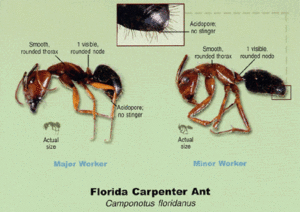
HABITAT
Florida carpenter ant species reside both outdoors and indoors in moist, decaying or hollow wood. They cut “galleries” into the wood grain to provide passageways for movement from section to section of the nest. Certain parts of a house, such as around and under windows, roof eaves, decks and porches, are more likely to be infested by Carpenter Ants because these areas are most vulnerable to moisture.
BIOLOGY AND BEHAVIOR
Sweets and proteins are the preferred food sources. Protein sources include both living and dead insects. Sweets included honeydew and sugar sources inside homes. These ants forage alone or in groups. Foraging ants are more likely to follow structural guidelines than trails. Peak foraging activity occurs at night. Colonies have a single queen. Workers are polymorphic.
DISTRIBUTION
Southeastern United States
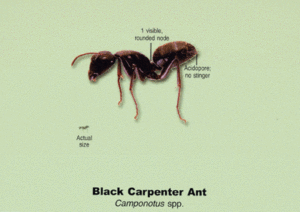
HABITAT
Black carpenter ant species reside both outdoors and indoors in moist, decaying or hollow wood. They cut “galleries” into the wood grain to provide passageways for movement from section to section of the nest. Certain parts of a house, such as around and under windows, roof eaves, decks and porches, are more likely to be infested by Carpenter Ants because these areas are most vulnerable to moisture.
BIOLOGY AND BEHAVIOR
Carpenter ants prefer sweets, although they also feed on living and dead insects. These ants forage alone or in groups, but do not follow trails very strongly. Peak foraging activity occurs at night. Colonies have only one queen and often consist of a parent nest with the queen and satellite nests. Workers are polymorphic.
DISTRIBUTION
Eastern and central United States
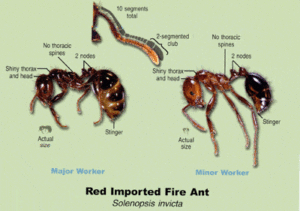
HABITAT/ WOOD PREFERENCE
Fire ants live primarily underground in vertical columns that extend down as far as three feet below the surface. After cool, rainy, weather fire ants clear blocked tunnels and expand chambers to create those telltale ant hill mounds that we all try to avoid stepping in. When the temperature is favorable, some of the ant colony will actual dwell in this above ground extension and place their developing brood in it.
BIOLOGY AND BEHAVIOR
These ants feed on sweets, fats, and proteins. They also feed upon living and dead insects and animals. Foraging ants form tightly linked trails. Colonies usually have one queen, but can also have multiple queens. Workers are extremely aggressive when the nest is disturbed. Workers are polymorphic, or highly variable in size.
DISTRIBUTION
Southeastern United States
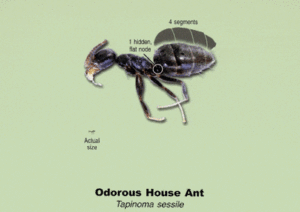
HABITAT
This ant is very opportunistic, living in a variety nesting sites, moving constantly to avoid the perils of inclement weather conditions. Not only will you find huge super colonies, but also many satellite colonies located close to the main colony. They are often located in mulch and under rocks or logs. Indoors, odorous house ants nest in wall and floor voids, and are often associated with humid, enclosed areas such as under toilets.
BIOLOGY AND BEHAVIOR
When crushed, the workers of this species give off an odor which resembles that of rotten coconut, giving them their odd name. Foragers search for dead insects, sweets, meats, and will tend insects for honeydew. Foraging ants strongly follow trails. Colonies can reach large numbers, with over 100,000 individuals. Odorous house ant colonies are polygynous. Workers are monomorphic.
DISTRIBUTION
Throughout the United States
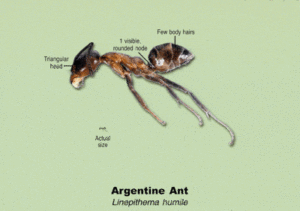
HABITAT
These ants will set up quarters in the ground, in cracks in concrete walls, in spaces between boards and timbers, even among belongings in human dwellings. In natural areas, they generally nest shallowly in loose leaf litter or beneath small stones, due to their poor ability to dig deeper nests. However, if a deeper nesting ant species abandons their nest, Argentine ant colonies will readily take over the space.
BIOLOGY AND BEHAVIOR
The worker ants are about 3 millimeters (0.12 in) long and can easily squeeze through cracks and holes no more than 1 millimeter (0.039 in) in size. Queens are two to four times the length of workers. Argentine ants feed on sweets and will tend insects for honeydew. They will also forage indoors for proteins and sweets. Foraging ants form tightly linked trails. The colonies of these ants have multiple queens in several nesting locations. The colonies can reach enormous sizes, with millions of individual ants. Workers are monomorphic, or uniform in size.
DISTRIBUTION
Southern United States and California, spreading northward into the Midwest
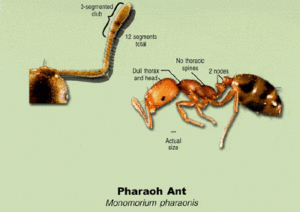
HABITAT
Pharaoh ants nest almost exclusively indoors, utilizing wall voids, cabinets, electrical sockets, and other humid, enclosed areas.
BIOLOGY AND BEHAVIOR
These ants feed on sweets and dead insects. Trail following is strong and tightly linked. The pharaoh ant has multiple queens and nesting locations. Colonies will nest indoors and forage outdoors for dead insects on window ledges. Workers are monomorphic.
DISTRIBUTION
Throughout the United States
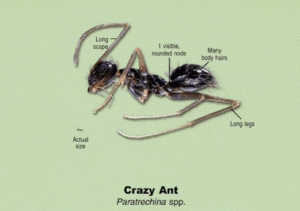
HABITAT
The crazy ant is highly adaptable, living in both very dry and rather moist habitats. The crazy ant thrives in places such as gasoline stations, convenience stores, and sidewalk cafes where workers may be seen transporting crumbs and insects attracted to lights. They can also be found under concrete slabs, crack in floors, and underneath plants.
BIOLOGY AND BEHAVIOR
Foragers prefer sweets such as honeydew from insects. Crazy ants also feed upon insects and seeds for protein. Workers are well known for their erratic gait, and often do not follow strongly to trails. Colonies are monogynous, with a single queen. Nests can be transient, workers may quickly move the colony if disturbed. Workers are monomorphic.
DISTRIBUTION
Southern United States
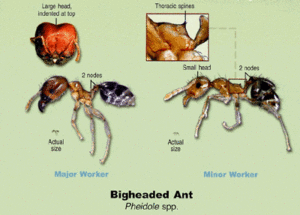
HABITAT
The Bigheaded ant is sometimes confused with subterranean termites because it may create debris-covered foraging tubes that are somewhat similar, albeit much more fragile, than termite tubes. More often these ants leave piles of loose sandy soil. Homeowners are annoyed by these “dirt piles” and by ants foraging in bathrooms, kitchens, around doors, and windows, as well as on exterior paved or brick walkways or driveways.
BIOLOGY AND BEHAVIOR
Bigheaded ants nest in colonies underground. Colonies can have several queens and super-colonies can be formed by budding, when a queen and workers leave the original nest and set up a new colony nearby without swarming. In Florida, nuptial flights of winged ants take place during the winter and spring and afterwards, fertilized queens shed their wings and find a suitable site to found a new colony where they start laying eggs. Each queen lays up to 290 eggs per month.
DISTRIBUTION
Throughout the United States
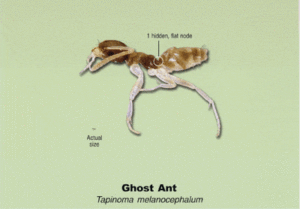
HABITAT
Outdoor nesting locations include trees and plants. Indoors, the ghost ant nests almost anywhere, including potted plants, wall voids, microwaves, and other enclosed areas.
BIOLOGY AND BEHAVIOR
The ghost ant gets its name from the pale color of its legs and abdomen. These ants have dark heads and thoraxes. The legs, antennae, and abdomen are so light that these ants are often difficult to see. Ghost ants are tiny ants, with the workers only about 1/16” long. Ghost ants prefer sweets and dead insects. Colonies contain many queens and may be subdivided into many nesting locations. Workers are monomorphic.
DISTRIBUTION
Florida and northwestern United States
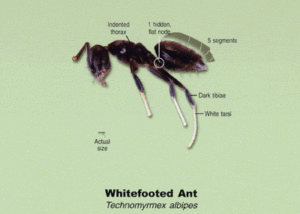
HABITAT
White-footed ants infest both urban and suburban habitats, spreading to other areas through the transportation of infested landscaping materials and plants. They can infest indoor areas in search of food and are found in bathrooms, kitchens and along the exteriors of homes.
BIOLOGY AND BEHAVIOR
These ants tend insects for honeydew. They also forage for dead insects. Foraging ants form tightly linked trails. Colony population levels can reach enormous numbers, with millions of ants. The colonies also have many queens. Food is transferred among the colony by production of trophic eggs, rather than by trophallaxis. Workers are fairly uniform in size.
DISTRIBUTION
Florida, Hawaii, and California
